Science (English Medium)
Academic Year: 2018-2019
Date & Time: 5th March 2019, 2:30 pm
Duration: 3h
Advertisements
1. All questions are compulsory. There are 27 questions in all.
2. This question paper has four sections: Section A, Section B, Section C and Section D.
3. Section A contains five questions of one mark each, Section B contains seven questions of two marks each, Section C contains twelve questions of three marks each, and Section D contains three questions of five marks each.
4. There is no overall choice. However, internal choices have been provided in two questions of one mark, two questions of two marks, four questions of three marks and three questions of five marks weightage. You have to attempt only one of the choices in such questions.
5. You may use the following values of physical constants wherever necessary.
c = 3 × 108 m/s
h = 6.63 × 10–34 Js
e = 1.6 × 10–19 C
μo = 4π × 10–7 T m A–1
ε0 = 8.854 × 10–12 C2 N–1 m–2
= 9 × 109 N m2 C–2
me = 9.1 × 10–31 kg
mass of neutron = 1.675 × 10–27 kg
mass of proton = 1.673 × 10–27 kg
Avogadro’s number = 6.023 × 1023 per gram mole
Boltzmann constant = 1.38 × 10–23 JK–1
Two metallic spheres A and B kept on insulating stands are in contact with each other. A positively charged rod P is brought near the sphere A as shown in the figure. The two spheres are separated from each other, and the rod P is removed. What will be the nature of charges on spheres A and B?
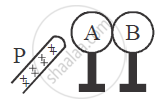
Chapter: [0.03] Current Electricity
A metal sphere is kept on an insulting stands. A negatively charged rod is brought near it, then the sphere is earthed as shown. On removing the earthing, and taking the negatively charged rod away, what will be the nature of charge on the sphere? Give reason for your answer.
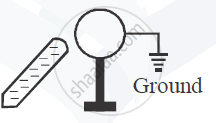
Chapter: [0.03] Current Electricity
A carbon resistor is shown in the figure. Using color code, write the value of the resistance.
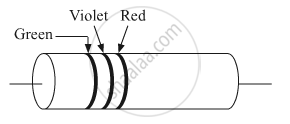
Chapter: [0.03] Current Electricity
State the condition under which a large magnification can be achieved in an astronomical telescope.
Chapter: [0.09] Ray Optics and Optical Instruments
How does the angle of minimum deviation of a glass prism vary if the incident violet light is replaced by red light?
Chapter: [0.09] Ray Optics and Optical Instruments

On the basis of the graphs shown in the figure, answer the following questions :
(a) Which physical parameter is kept constant for the three curves?
(b) Which is the highest frequency among v1, v2, and v3?
Chapter: [0.11] Dual Nature of Radiation and Matter
Define amplitude modulation in a communication system.
Chapter: [0.15] Communication Systems
Five point charges, each of charge +q are placed on five vertices of a regular hexagon of side 'l '. Find the magnitude of the resultant force on a charge -q placed at the centre of the hexagon.
Chapter: [0.01] Electric Charges and Fields
A simple pendulum consists of a small sphere of mass m suspended by a thread of length l. The sphere carries a positive charge q. The pendulum is placed in a uniform electric field of strength E directed vertically downwards. Find the period of oscillation of the pendulum due to the electrostatic force acting on the sphere, neglecting the effect of the gravitational force.
Chapter: [0.01] Electric Charges and Fields
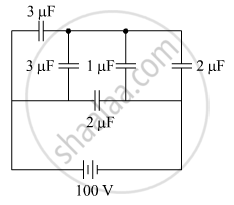
The figure shows a network of five capacitors connected to a 100 V supply. Calculate the total energy stored in the network.
Chapter: [0.02] Electrostatic Potential and Capacitance
A 0⋅5 m long solenoid of 10 turns/cm has the area of cross-section 1 cm2. Calculate the voltage induced across its ends if the current in the solenoid is changed from 1 A to A in 0⋅1 s.
Chapter: [0.06] Electromagnetic Induction
A small flat search coil of area 5cm2 with 140 closely wound turns is placed between the poles of a powerful magnet producing magnetic field 0.09T and then quickly removed out of the field region. Calculate:
(a) Change of magnetic flux through the coil, and
(b) emf induced in the coil.
Chapter: [0.06] Electromagnetic Induction
For paraxial rays, show that the focal length of a spherical mirror is one-half of its radius of curvature.
Chapter: [0.09] Ray Optics and Optical Instruments
Obtain Bohr’s quantisation condition for angular momentum of electron orbiting in nth orbit in hydrogen atom on the basis of the wave picture of an electron using de Broglie hypothesis.
Chapter: [0.12] Atoms
Plot a graph showing the variation of undecayed nuclei N versus time t. From the graph, find out how one can determine the half-life and average life of the radioactive nuclei.
Chapter: [0.13] Nuclei
Write two distinguishing features of nuclear forces.
Chapter: [0.13] Nuclei
Complete the following nuclear reactions for α and β deca :
(i) `"_92^238U ->? + _2^4He + Q`
(ii) `"_11^22Na ->? + _10^22Ne + v`
Chapter: [0.13] Nuclei
Explain briefly, using a proper diagram, the difference in the behavior of a conductor and a dielectric in the presence of an external electric field.
Chapter: [0.02] Electrostatic Potential and Capacitance
Define the term polarization of a dielectric and write the expression for a linear isotropic dielectric in terms of electric field.
Chapter: [0.02] Electrostatic Potential and Capacitance
Twelve wires each having a resistance of 3 Ω are connected to form a cubical network. A battery of 10 V and negligible internal resistance is connected across the diagonally opposite corners of this network. Determine its equivalent resistance and the current along each edge of the cube.
Chapter: [0.03] Current Electricity
A student uses the circuit diagram of a potentiometer as shown in the figure
(a) for a steady current I passing through the potentiometer wire, he gets a null point for the cell ε1. and not for ε2. Give the reason for this observation and suggest how this difficulty can be resolved.
(b) What is the function of resistance R used in the circuit? How will the change in its value affect the null point?
(c) How can the sensitivity of the potentiometer be increased?
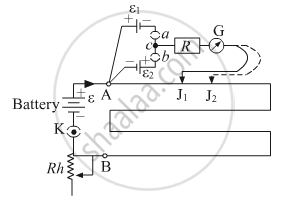
Chapter: [0.03] Current Electricity
Show that the time period (T) of oscillations of a freely suspended magnetic dipole of magnetic moment (m) in a uniform magnetic field (B) is given by `"T" = 2pi sqrt("I"/"mB")`, where I is a moment of inertia of the magnetic dipole.
Chapter: [0.07] Alternating Current
Advertisements
Identify the following magnetic materials :
Chapter: [0.05] Magnetism and Matter
How are eddy currents generated in a conductor which is subjected to a magnetic field?
Chapter: [0.06] Electromagnetic Induction
Write two examples of their useful applications .
Chapter: [0.06] Electromagnetic Induction
How can the disadvantages of eddy currents be minimized?
Chapter: [0.06] Electromagnetic Induction
An ac circuit as shown in the figure has an inductor of inductance L and a resistor of resistance R connected in series. Using the phasor diagram, explain why the voltage in the circuit will lead the current in phase.
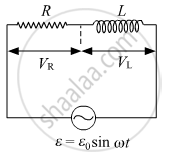
Chapter: [0.07] Alternating Current
The potential difference across the resistor is 160 V and that across the inductor is 120 V. Find the effective value of the applied voltage. If the effective current in the circuit is 1⋅0 A, calculate the total impedance of the circuit.

Chapter: [0.07] Alternating Current
What will be the potential difference in the circuit when direct current is passed through the circuit?
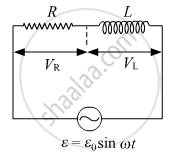
Chapter: [0.02] Electrostatic Potential and Capacitance
An ac circuit consists of a series combination of circuit elements X and Y. The current is ahead of the voltage in phase by `pi/4`. If element X is a pure resistor of 100 Ω,
(a) name the circuit element Y.
(b) calculate the rms value of current, if rms of voltage is 141 V.
(c) what will happen if the ac source is replaced by a dc source
Chapter: [0.02] Electrostatic Potential and Capacitance
Name the radiation of the electromagnetic spectrum which is used for the following:
Radar and Give the frequency range.
Chapter: [0.08] Electromagnetic Waves
Name the radiation of the electromagnetic spectrum which is used for the following:
To photograph internal parts of the human body and Give the frequency range
Chapter: [0.08] Electromagnetic Waves
Name the radiation of the electromagnetic spectrum which is used for the following:
For taking photographs of the sky during the night and foggy conditions . Give the frequency range
Chapter: [0.08] Electromagnetic Waves
A converging beam of light traveling in air converges at a point P as shown in the figure. When a glass sphere of refractive index 1⋅5 is introduced in between the path of the beam, calculate the new position of, the image. Also, draw the ray diagram for the image formed.
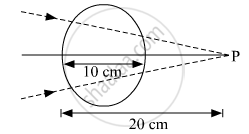
Chapter: [0.09] Ray Optics and Optical Instruments
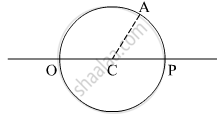
Chapter: [0.09] Ray Optics and Optical Instruments
Explain how an unpolarised light gets polarised when incident on the interface separating the two transparent media.
Chapter: [0.1] Wave Optics
Greenlight is an incident at the polarising angle on a certain transparent medium. The angle of refraction is 30°.
Find
(i) polarising angle, and
(ii) refractive index of the medium.
Chapter: [0.1] Wave Optics
Plot a graph to show the variation of stopping potential with frequency of incident radiation in relation to photoelectric effect.
Chapter: [0.11] Dual Nature of Radiation and Matter
Use Einstein's photoelectric equation to show how from this graph,
(i) Threshold frequency, and
(ii) Planck's constant can be determined.
Chapter: [0.11] Dual Nature of Radiation and Matter
How does one explain the emission of electrons from a photosensitive surface with the help of Einstein’s photoelectric equation?
Chapter: [0.11] Dual Nature of Radiation and Matter
The work function of aluminum is 4⋅2 eV. If two photons each of energy 2⋅5 eV are incident on its surface, will the emission of electrons take place? Justify your answer.
Chapter: [0.11] Dual Nature of Radiation and Matter
The stopping potential in an experiment on photoelectric effect is 1.5V. What is the maximum kinetic energy of the photoelectrons emitted? Calculate in Joules.
Chapter: [0.11] Dual Nature of Radiation and Matter
Advertisements
(i) Write the truth tables of the logic gates marked P and Q in the given circuit.
(ii) Write the truth table for the circuit.

Chapter: [0.14] Semiconductor Electronics - Materials, Devices and Simple Circuits
Why are NOR gates considered as universal gates?
Chapter: [0.14] Semiconductor Electronics - Materials, Devices and Simple Circuits
Explain how a potential barrier is developed in a p-n junction diode.
Chapter: [0.14] Semiconductor Electronics - Materials, Devices and Simple Circuits
Draw the circuit arrangement for studying the V-I characteristics of a p-n junction diode in reverse bias. Plot the V-I characteristics in this case.
Chapter: [0.14] Semiconductor Electronics - Materials, Devices and Simple Circuits
What do you mean by bandwidth of a signal? Give its importance.
Chapter: [0.15] Communication Systems
Differentiate between Analog and Digital communication.
Chapter: [0.15] Communication Systems
Write the functions of the transducer and repeaters.
Chapter: [0.15] Communication Systems
State and explain the law used to determine the magnetic field at a point due to a current element. Derive the expression for the magnetic field due to a circular current-carrying loop of radius r at its center.
Chapter: [0.04] Moving Charges and Magnetism
A long wire with a small current element of length 1 cm is placed at the origin and carries a current of 10 A along the X-axis. Find out the magnitude and direction of the magnetic field due to the element on the Y-axis at a distance 0.5 m from it.
Chapter: [0.04] Moving Charges and Magnetism
Derive the expression for the magnetic field due to a current-carrying coil of radius r at a distance x from the center along the X-axis.
Chapter: [0.04] Moving Charges and Magnetism
A straight wire carrying a current of 5 A is bent into a semicircular arc radius 2 cm as shown in the figure. Find the magnitude and direction of the magnetic field at the center of the arc

Chapter: [0.04] Moving Charges and Magnetism
(a) Can the interference pattern be produced by two independent monochromatic sources of light? Explain.
(b) The intensity at the central maximum (O) in Young's double-slit experimental set-up shown in the figure is IO. If the distance OP equals one-third of the fringe width of the pattern, show that the intensity at point P, would `"I"_°/4`
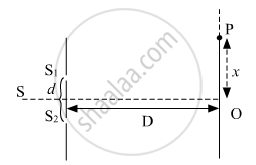
(c) In Young's double-slit experiment, the slits are separated by 0⋅5 mm and the screen is placed 1⋅0 m away from the slit. It is found that the 5th bright fringe is at a distance of 4⋅13 mm from the 2nd dark fringe. Find the wavelength of light used.
Chapter: [0.1] Wave Optics
Derive the relation a sin θ = λ for the first minimum of the diffraction pattern produced due to a single slit of width 'a' using light of wavelength λ.
Chapter: [0.1] Wave Optics
State with reason, how the linear width of the central maximum will be affected if
(i) monochromatic yellow light is replaced with red light, and
(ii) distance between the slit and the screen is increased.
Chapter: [0.1] Wave Optics
Using the monochromatic light of the wavelength in the experimental set-up of the diffraction pattern as well as in the interference pattern where the slit separation is 1 mm, 10 interference fringes are found to be within the central maximum of the diffraction pattern. Determine the width of the single slit, if the screen is kept at the same distance from the slit in the two cases.
Chapter: [0.1] Wave Optics
Draw a circuit diagram of an n-p-n transistor with its emitter-base junction forward biased and base-collector junction reverse biased. Briefly describe its working.
Explain how a transistor in its active state exhibits a low resistance at its emitter-base junction and high resistance at its base-collector junction.
Chapter: [0.14] Semiconductor Electronics - Materials, Devices and Simple Circuits
Derive the expression for the voltage gain of a transistor amplifier in CE configuration in terms of the load resistance RL, current gain βa and input resistance.
Explain why input and output voltages are in the opposite phase.
Chapter: [0.14] Semiconductor Electronics - Materials, Devices and Simple Circuits
Write the important considerations which are to be taken into account while fabricating a p-n junction diode to be used as a Light Emitting Diode (LED). What should be the order of the band gap of an LED, if it is required to emit light in the visible range? Draw a circuit diagram and explain its action.
Chapter: [0.14] Semiconductor Electronics - Materials, Devices and Simple Circuits
Draw the V-I characteristics of an LED. State two advantages of LED lamps over convertional incandescent lamps.
Chapter: [0.14] Semiconductor Electronics - Materials, Devices and Simple Circuits
Other Solutions
Submit Question Paper
Help us maintain new question papers on Shaalaa.com, so we can continue to help studentsonly jpg, png and pdf files
CBSE previous year question papers Class 12 Physics with solutions 2018 - 2019
Previous year Question paper for CBSE Class 12 Physics-2019 is solved by experts. Solved question papers gives you the chance to check yourself after your mock test.
By referring the question paper Solutions for Physics, you can scale your preparation level and work on your weak areas. It will also help the candidates in developing the time-management skills. Practice makes perfect, and there is no better way to practice than to attempt previous year question paper solutions of CBSE Class 12.
How CBSE Class 12 Question Paper solutions Help Students ?
• Question paper solutions for Physics will helps students to prepare for exam.
• Question paper with answer will boost students confidence in exam time and also give you an idea About the important questions and topics to be prepared for the board exam.
• For finding solution of question papers no need to refer so multiple sources like textbook or guides.
